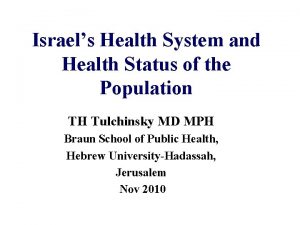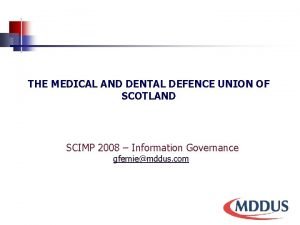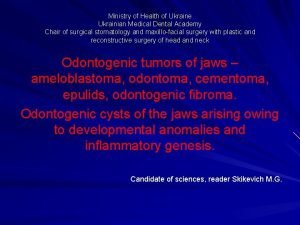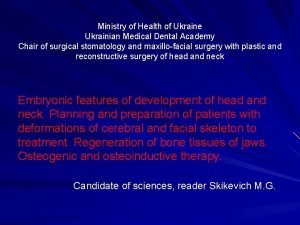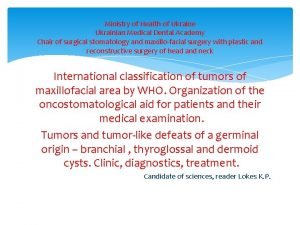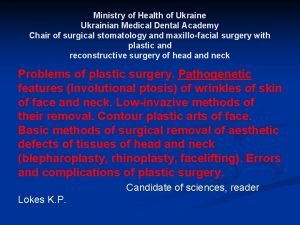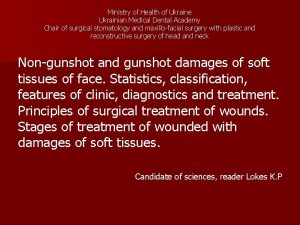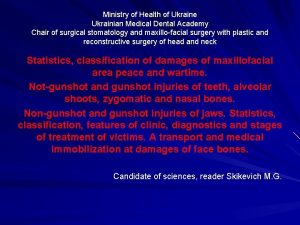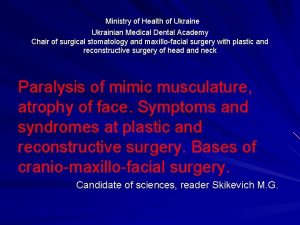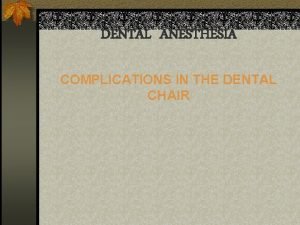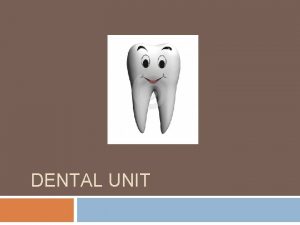Ministry of Health of Ukraine Ukrainian Medical Dental












































- Slides: 44

Ministry of Health of Ukraine Ukrainian Medical Dental Academy Chair of surgical stomatology and maxillo-facial surgery with plastic and reconstructive surgery of head and neck Surgical treatment of skeletal anomalies of bite, orthognatic (orthodontic, gnatic) surgery. Distractional-compressive osteogenesis. Candidate of sciences, reader Skikevich M. G.

Lecture plan 1. 2. 3. 4. 5. 6. Skeletal anomalies of bite Orthognatic surgery Causes of anomalies of size and shape of the tooth Anomalies of teeth position Cleft lip (cheiloschisis) and cleft palate Distractional-compressive osteogenesis

n n Open bite This type of malocclusion is characterized by the absence of teeth in Central occlusion in the vertical direction, i. e. relative to a horizontal plane. Maybe open bite not only the front but also in the posterior teeth unilaterally, bilaterally, though very rare. This anomaly, like many others, can be observed in different age periods, namely milk, mixed and permanent dentition.

causes of malocclusion: n n n Causes and clinical manifestations of malocclusion are very diverse, which complicates the possibility of targeted prevention and pathogenetic treatment. D. A. Kalvelis distinguish the origin of the two forms of malocclusion: true or rachitic, traumatic (from long-term injury of finger sucking, tongue, lips, cheeks, and other items).

Symptoms of malocclusion: n In skeletal open bite as a rule, difficult to biting and chewing of food, dominated by hinged movement of the lower jaw, so when chewed involved language that helps to stretch the food. Violated the pronunciation of the labial, jazychnogo and hissing sounds: "p", "b", "m", "f". You should pay attention to the swallowing, which in skeletal open bite recalls infant or infantile. Changes the breath, becoming mostly of the mouth, causing dryness of the mucous membrane.

Diagnosis of malocclusion: n The Frankfurt horizontal (FH), the ratio of occlusal surfaces of both jaws showed that of all forms of malocclusion characterized by the following changes: palatal plane is displaced downwards and backwards relative to the Frankfurt horizontal, the angle between them is negative, the height of the alveolar process of maxilla in lateral parts is significantly reduced. To violations of the facial skeleton is also the high location of the temporomandibular joint.

Treatment of Open bite: n Along with a comprehensive treatment, that is, hardware, surgical, orthopedic, it is necessary to improve prevention and early treatment of open bite is more conservative, especially in children allocated to the risk group. The basis for this should be timely diagnosis, identification of risk groups and prognosis.

R. G. Alexander recommends for early treatment of malocclusion following equipment: 2 x 4 (two rings with locks on the upper molars and 4 brackets on the incisors n face-bow with a high thrust to implement molarsn palatal arch the delay of eruption of the upper molarsn lingual arch the delay of eruption of lower molars. n

Treatment of open bite n Treatment of open bite can be performed using functional, mechanical operating and combined apparatus: base plates on the upper and lower jaw, with occlusal overlays on the lateral teeth, retraction arc and a focus for the language - extending plate on the upper jaw, with the sector saw cut and occlusal overlays on the lateral teeth, the regulators R. Frauml-nkel.

n Causes of anomalies of size and shape of the tooth is the influence of pathogenic factors on the mother's body at the time of laying the rudiments of the teeth. Pathogenic factors can be of different nature, and eating disorders women, and exposure to chemical agents, and the influence of pathogenic microorganisms and viruses, and a lack of trace elements in water and food. These anomalies may be due to genetic factors and endocrine disorders.

n Macrodontia - increase in mesiodistal dimensions of teeth compared with their average performance. Can be broken sizes of cutters, mostly upper. This anomaly is characteristic, as a rule, the Central upper incisors. A significant increase in the size of the teeth is detected visually, the degree of increase is determined by comparing the measurement results with the average

n Diagnosis. The sharp increase in the size of teeth diagnosed as megalomania. Determine the following teeth: the width, thickness and height of the crown part. Width or mesiodistally the size of the premolars and Medio-lateral incisors and canines - measure the widest part of the tooth crown, the height from the gingival margin at the level of the neck of the tooth to the cutting edges of the cutters of the hill canines premolars and molars. The thickness is the greatest option crowns in the oral-vestibular direction.

n Microdontia - reducing the size of the teeth compared to the average data. Reduce the size of all the teeth, but, as a rule, it concerns only the individual. Most common anomaly of upper lateral incisors. Severe microdontia diagnosed visually. Anomaly the size of the teeth is often associated with an abnormality of their form. Compare the width of the tooth at the coronal portion and the available room for him in the dentition with the anomalies of his position becomes essential to predict and influence the choice of treatment.

n Diagnosis. Because the shape, parameters, and occlusion of the dentition depend on the size of the teeth, you should determine the interdependence of the dimensions of the upper and lower teeth, which is important as in occlusion of the deciduous teeth and in the mixed dentition and occlusion of the permanent teeth. It should, in particular, from the established regularities: the sum of the width of the crowns of permanent teeth any time (occlusion of deciduous teeth) upper, on average, at 7. 1 mm, bottom - 5. 3 mm.

Malformed shape also have: n- The teeth of Hutchinson n - Teeth Fournier n - The teeth of Pfluger

n - The teeth of Hutchinson - upper Central incisors with Otvertka and barrel shape of the crown (the size of the neck more than the cutting edge) having the semilunar notch on the cutting edge. Semilunar notch can be covered with enamel, but sometimes the enamel is observed only at the corners of the tooth, and in the middle part of the dentin, not enamel coated.

n - Teeth Fournier - like teeth of Hutchinson, but without the semilunar notch on the cutting edge. Teeth Fournier and Hutchinson occur in congenital syphilis and other diseases.

n - The teeth of Pfluger - the first large molars (six) in which the size of a crown around neck more than the chewing surfaces, and bumps are underdeveloped. The development of teeth Pfluger explain the action of the syphilitic infection. It is noted this anomaly of development of tooth shape, as "twisted" teeth, which is mainly manifested in the appearance of the Central and lateral incisors. Special pathology is the presence of "styloid" teeth, this pathology is not uncommon and affects the lateral incisors of the

n Anomalies of teeth position. This is the most frequent anomaly. Distinguish oral (palatal, lingual), vestibular, mesial, distal position, rotation of teeth, transposition, low, high position. Palatine. , lingual and vestibular teething is caused by narrowing of the dentition, the presence of supernumerary teeth. The teeth turn around the axis are also observed narrowing of the dentition and combined with the change of position: tilt, shift. Transposition of teeth is an anomaly of tooth position, characterized by the replacement location of the adjacent teeth.

n Anomalies of the roots. These anomalies occur frequently and appear diverse. The number of roots may be reduced or increased, and they can be bent in different directions (sometimes at an angle of 90°). The deviation of the root from the normal direction substantially impedes the passage of the channel, and sometimes makes it impossible. This should be considered in the treatment of pulpitis and periodontitis.

Symptoms of Anomalies of dentition: n There are the following types of anomalies of the dentition: violations of the shape and size of the dentition. Of breaking the sequence of location of the teeth, the symmetry of their position, and contacts between adjacent teeth lead to abnormalities the shape and size of the dentition. There are clinical signs of anomalies of dentition and objective anthropometric methods of their diagnostics.

n Clinical diagnosis of anomalies of dentition is carried out at the oral cavity examination, anthropometric - on plaster models of the jaws with the help of the meter, compass and ruler.

n Permanent teeth should be sure to contact between their side surfaces. The presence of three and diastemata between the permanent teeth is considered an anomalous phenomenon and highlighted in a separate nosological form.

Cleft lip (cheiloschisis) and cleft palate (palatoschisis) (colloquially known as harelip), which can also occur together as cleft lip and palate, are variations of a type of clefting congenital deformity caused by abnormal facial development during gestation. A cleft is a fissure or opening—a gap. It is the non-fusion of the body's natural structures that form before birth. 1 in 700 children born do have a cleft lip and/or a palate. Clefts can also affect other parts of the face, such as the eyes, ears, nose, cheeks and forehead. In 1976, Dr. Paul Tessier described

Cleft Lip & Palate If the cleft does not affect the palate structure of the mouth it is referred to as cleft lip. Cleft lip is formed in the top of the lip as either a small gap or an indentation in the lip (partial or incomplete cleft) or it continues into the nose (complete cleft). Lip cleft can occur as a one sided (unilateral) or two sided (bilateral). It is due to the failure of fusion of the maxillary and medial nasal processes (formation of the primary palate).

Cleft Lip & Palate A mild form of a cleft lip is a microform cleft. A microform cleft can appear as small as a little dent in the red part of the lip or look like a scar from the lip up to the nostril. In some cases muscle tissue in the lip underneath the scar is affected and might require reconstructive surgery. It is advised to have newborn infants with a microform cleft checked with a craniofacial team as soon as possible to determine the severity of the cleft.

Cleft palate n Cleft palate is a condition in which the two plates of the skull that form the hard palate (roof of the mouth) are not completely joined. The soft palate is in these cases cleft as well. In most cases, cleft lip is also present. n Palate cleft can occur as complete (soft and hard palate, possibly including a gap in the jaw) or incomplete (a 'hole' in the roof of the mouth, usually as a cleft soft palate). When cleft palate occurs, the uvula is usually split. It occurs due to the failure of fusion of the lateral palatine processes, the nasal septum, and/or the median palatine processes (formation of the secondary palate). n The hole in the roof of the mouth caused by a cleft connects the mouth directly to the nasal cavity.

Cleft palate Submucous cleft palate (SMCP) can also occur, which is an occult cleft of the soft palate with a classic clinical triad of bifid uvula, a furrow along the midline of the soft palate, and a notch in the posterior margin of the hard palate.

Causes of clefts The development of the face is coordinated by complex morphogenetic events and rapid proliferative expansion, and is thus highly susceptible to environmental and genetic factors, rationalising the high incidence of facial malformations. During the first six to eight weeks of pregnancy, the shape of the embryo's head is formed. Five primitive tissue lobes grow: a) one from the top of the head down towards the future upper lip; (Frontonasal Prominence) b-c) two from the cheeks, which meet the first lobe to form the upper lip; (Maxillar Prominence) d-e) and just below, two additional lobes grow from each side, which form the chin and lower lip; (Mandibular Prominence)

Causes of clefts n If these tissues fail to meet, a gap appears where the tissues should have joined (fused). This may happen in any single joining site, or simultaneously in several or all of them. The resulting birth defect reflects the locations and severity of individual fusion failures (e. g. , from a small lip or palate fissure up to a completely malformed face). n The upper lip is formed earlier than the palate, from the first three lobes named a to c above. Formation of the palate is the last step in joining the five embryonic facial lobes, and involves the back portions of the lobes b and c. These back portions are called palatal shelves, which grow towards each other until they fuse in the middle. This process is very vulnerable to multiple toxic substances, environmental pollutants, and nutritional imbalance. The biologic mechanisms of mutual recognition of the two cabinets, and the way they are glued together, are quite complex and

Causes of clefts Genetic factors contributing to cleft lip and cleft palate formation have been identified for some syndromic cases, but knowledge about genetic factors that contribute to the more common isolated cases of cleft lip/palate is still patchy. Syndromic cases: The Van der Woude Syndrome is caused by a specific variation in the gene IRF 6 that increases the occurrence of these deformities threefold. Another syndrome, Siderius X-linked mental retardation, is caused by mutations in the PHF 8 gene (OMIM 300263); in addition to cleft lip and/or palate, symptoms include facial dysmorphism and mild mental retardation. In some cases, cleft palate is caused by syndromes which also cause other problems. Stickler's Syndrome can cause cleft lip and palate, joint pain, and myopia. Loeys-Dietz syndrome can cause cleft palate or bifid uvula, hypertelorism, and aortic aneurysm. Cleft lip/palate may be present in many different chromosome

Causes of clefts

Causes of clefts n Non-syndromic cases: Many genes associated with syndromic cases of cleft lip/palate (see above) have been identified to contribute to the incidence of isolated cases of cleft lip/palate. This includes in particular sequence variants in the genes IRF 6, PVRL 1 and MSX 1. The understanding of the genetic complexities involved in the morphogenesis of the midface, including molecular and cellular processes, has been greatly aided by research on animal models, including of the genes BMP 4, SHH, SHOX 2, FGF 10 and MSX 1. n If a person is born with a cleft, the chances of that person having a child with a cleft, given no other obvious factor, rises to 1 in 14. Many clefts run in families, even though in some cases there does not seem to be an identifiable syndrome present, possibly because of the current incomplete genetic understanding of midfacial development.

Causes of clefts Environmental influences may also cause, or interact with genetics to produce, orofacial clefting. An example for how environmental factors might be linked to genetics comes from research on mutations in the gene PHF 8 that cause cleft lip/palate (see above). It was found that PHF 8 encodes for a histone lysine demethylase, and is involved in epigenetic regulation. The catalytic activity of PHF 8 depends on molecular oxygen, a fact considered important with respect to reports on increased incidence of cleft lip/palate in mice that have been exposed to hypoxia early during pregnancy. In humans, fetal cleft lip and other congenital abnormalities have also been linked to maternal hypoxia, as caused by e. g. maternal smoking, maternal alcohol abuse or some forms of maternal hypertension treatment. Other environmental factors that have been studied include: seasonal causes (such as pesticide exposure); maternal diet and vitamin intake; retinoids - which are members of the vitamin A family; anticonvulsant drugs; alcohol; cigarette use; nitrate compounds; organic solvents; parental exposure to lead; and illegal drugs (cocaine, crack cocaine, heroin, etc). Current research continues to investigate the extent to which Folic acid can reduce the incidence of clefting.

Diagnosis n n n n History –Prenatal and birth history –History of prenatal drug/medication use –Family history of cleft lip or palate, or other birth defects –Ethnic background Physical exam –Location and extent of the defect –Presence or absence of submucosal cleft palate (must be palpated, because it may not be visible beneath the oral mucosa) –Dental examination –Cardiac examination

Signs and symptoms n Orofacial cleft defects are divided into two major groups: cleft lip with or without cleft palate or cleft palate only. Cleft of the lip may involve the alveolus (premaxilla) and may extend through the palate (hard and soft). Congenital clefts of the face occur most commonly in the upper lip. They can range from a simple notch to a complete cleft from the lip edge, through the floor of the nostril and through the alveolus. Cleft lip can occur on either or both sides of the midline but rarely along the midline itself. A cleft lip involving only one side is a unilateral cleft lip, and a cleft on both sides of the midline is a bilateral cleft lip. When a bilateral cleft lip involves clefting of the alveolus on both sides of the premaxilla, the premaxilla is separated from the maxilla into a freely moving segment.

Signs and symptoms n A cleft of the palate only may be partial or complete, involving only the soft palate or extending from the soft palate completely through the hard palate. A cleft palate can occur alone or with a cleft lip. Isolated cleft palate is more commonly associated with congenital defects other than isolated cleft lip with or without cleft palate. (See Variations of cleft lip and cleft palate. ) The constellation of U-shaped cleft palate, mandibular hypoplasia, and glossoptosis is known as Pierre Robin syndrome, or Robin syndrome can occur as an isolated defect or one feature of many different syndromes; therefore, a comprehensive genetic evaluation is suggested for infants with Robin syndrome. Because of the mandibular hypoplasia and glossoptosis, careful evaluation and management of the airway are mandatory for infants with Robin syndrome.

Several cheilorrhaphy techniques q q A and B, le. Mesurier technique tor incomplete unilat- eral cleft. C and D. Tennison operation. E and F, Wynr operation. G and H, Millard operation (i. e. . , rotation advancement technique).

Palatorrhaphy n n n n Variation of von Langenbeck operation for concomitant hard and soft palate closure. It yeses three-layer closure for soft palate (i. e. , nasal mucosa, muscle, oral mucosa) and two-layer closure for hard palate (i. e. , flap from vomer and nasal door to produce nasal closure, palatal flaps for oral clo- sure). A, Removing mucosa from margin of cleft. B, Mucoperiosteal flaps on hard palate are developed; note lateral releasing incisions. C, Sutures placed into nasal mucosa after development of nasal flaps from vomer and nasal floor. Sutures are placed so that knots will be on nasal side. D, Nasal mucosa has been closed. E, Frontal section showing repair of nasal mucosa. F, Closure of oral mucoperiosteum,

Palatorrhaphy n n n Vomer flap technique for closure of hard palate cleft (bilateral in this case). A, Incisions through nasal mucosa on underside of nasal septum (i. e. , vomer) and mucosa of cleft margins. B, Mucosa of nasal septum is dissected off nasal septum and inserted under palatal mucosa at margins of cleft. This is onelayer nasal closure only. Connective tissue undersurface of nasal mucosa will epithelialize. This technique, because it does not require extensive elevation of palatal mucoperiosteum, producer less starring with attendant growth restriction.

Palatorrhaphy (triple-layered soft palate closure) n n n A, Excisfon of mucosa at cleft margin. B, Dissection of nasal mjcosa from soft palate to facilitate closure. Nasal mucosa is sutured together with knots tied or nasal (i. e. , superior) surface. Note small incision made to insert instrument for hamular process fracture. This maneuver refeases tensor veli palatini and facilitates approximation in midline. C, Muscle h dissected from insertion into hard palate, and sutures are placed to approximate muscle in midline. D, Closure of oral mucosa is accomplished last. E, Layered closure of soft palate

Alveolar cleft bone grafting n n A, Preoperative defect viewed from labial aspect. Fistula extends, into nasal cavity. B, Incision divides mucosa fistula, which allows development of nasal and oral flaps. C, Mucosal flap developed from lining of fistula is turned inward, up into nasal cavity, and sutured in watertight manner D, Bone graft material is packed into cleft, and oral mucosa is closed in watertight manner.

Questions for discussion of the lecture 1. 2. 3. 4. 5. How do you understand the word anomaly? What issues does orthognathic surgery deal with? What types of bite do you know? How do you understand that? Distractionalcompressive osteogenesis. What reasons? Causes of anomalies of size and shape of the tooth

Thank you for attention!
 Ministry of infrastructure ukraine
Ministry of infrastructure ukraine Amanda bleckmann
Amanda bleckmann Health ministry uk
Health ministry uk Israel ministry of health
Israel ministry of health Estonia health ministry
Estonia health ministry Diana shehu devaja
Diana shehu devaja Ukrainian national library
Ukrainian national library Ukrainian alphabet song
Ukrainian alphabet song History of pysanky
History of pysanky Christ our pascha catechism
Christ our pascha catechism Ukrainian writers quotes
Ukrainian writers quotes Ukrainian women's association of canada
Ukrainian women's association of canada Famous ukraine sayings
Famous ukraine sayings Ukrainian farmers
Ukrainian farmers Association of ukrainian guides
Association of ukrainian guides Ukrainian national credit union association
Ukrainian national credit union association Ukrainian state center for international education
Ukrainian state center for international education Traditional ukraine food
Traditional ukraine food Famous ukrainian americans
Famous ukrainian americans Medical defence union scotland
Medical defence union scotland Social engineering phase in public health
Social engineering phase in public health Caries risk assessment form texas medicaid
Caries risk assessment form texas medicaid Tools of dental public health
Tools of dental public health Borrego dental insurance
Borrego dental insurance Blanket referral in dentistry
Blanket referral in dentistry Askov in public health dentistry
Askov in public health dentistry Albany area primary health care rural clinic
Albany area primary health care rural clinic Dental health aide therapist
Dental health aide therapist Doctors license number
Doctors license number Greater baltimore medical center medical records
Greater baltimore medical center medical records Hepburn osteometric board
Hepburn osteometric board Torrance memorial cardiac rehab
Torrance memorial cardiac rehab Cartersville medical center medical records
Cartersville medical center medical records Language of ukraine
Language of ukraine Ukraine geographical position
Ukraine geographical position The geographical position of ukraine
The geographical position of ukraine Ukraine main religion
Ukraine main religion Holubzi
Holubzi Oleeh mail
Oleeh mail Ukraine european
Ukraine european Our national symbols
Our national symbols Science and technology center in ukraine
Science and technology center in ukraine Preschool primary secondary
Preschool primary secondary Accreditation ukraine
Accreditation ukraine Ukraine accreditation body
Ukraine accreditation body



